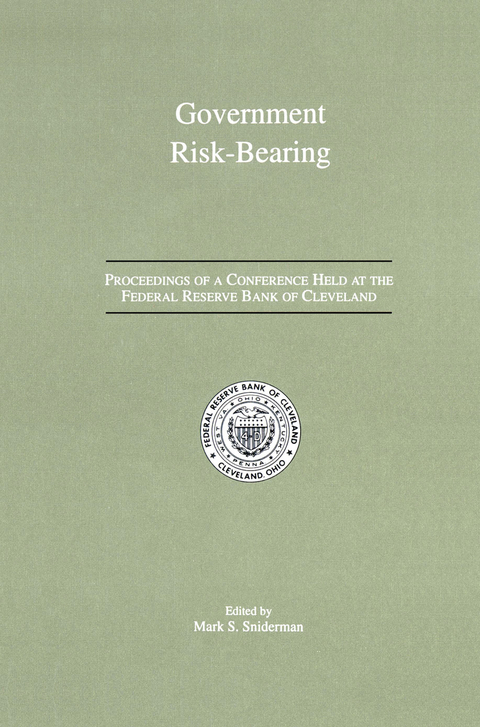
Government Risk-Bearing
Proceedings of a Conference Held at the Federal Reserve Bank of Cleveland, May 1991
Seiten
2012
|
Softcover reprint of the original 1st ed. 1993
Springer (Verlag)
978-94-010-4967-2 (ISBN)
Springer (Verlag)
978-94-010-4967-2 (ISBN)
Proceedings of a Conference held at the Federal Reserve Bank of Cleveland
The u.s. government bulks large in the nation's financial markets. The huge volume of government-issued and -sponsored debt affects the pricing and volume ofprivate debt and, consequently, resource allocation between competing alternatives. What is often not fully appreciated is the substantial influence the federal government wields overresource allocation through its provisionofcreditandrisk-bearing services to the private economy. Because peopleand firms generally seekto avoid risk, atsomeprice they are willing to pay another party to assume the risk they would otherwise face. Insurance companies are a class of private-sector firms one commonly thinks of as providing these services. As the federal government has expanded its presence in the U.S. economy during this century, it has increasingly developed programs aimed at bearing risks that the private sector either would not take on at any price, or would take on but atapricethoughtto besogreatthatmostpotentialbeneficiarieswouldnotpurchase the coverage. Today, roughly three-fifths of all nonfederal credit outstanding is 1 assisted by some form of federal program. The federal government provides insurance of many private pension plans through the Pension Benefit Guaranty Corporation, subsidizesand implicitly guarantees the liabilitiesofseveral agencies dominating secondary loan markets (for example, the Federal National Mortgage Association, Federal Home Loan Mortgage Corporation, and Student Loan Mar ketingAssociation),andeithermakesdirectloansorguaranteesprivatelygenerated loans through a varietyofcreditprograms to farmers, exporters, home purchasers, and others.
The u.s. government bulks large in the nation's financial markets. The huge volume of government-issued and -sponsored debt affects the pricing and volume ofprivate debt and, consequently, resource allocation between competing alternatives. What is often not fully appreciated is the substantial influence the federal government wields overresource allocation through its provisionofcreditandrisk-bearing services to the private economy. Because peopleand firms generally seekto avoid risk, atsomeprice they are willing to pay another party to assume the risk they would otherwise face. Insurance companies are a class of private-sector firms one commonly thinks of as providing these services. As the federal government has expanded its presence in the U.S. economy during this century, it has increasingly developed programs aimed at bearing risks that the private sector either would not take on at any price, or would take on but atapricethoughtto besogreatthatmostpotentialbeneficiarieswouldnotpurchase the coverage. Today, roughly three-fifths of all nonfederal credit outstanding is 1 assisted by some form of federal program. The federal government provides insurance of many private pension plans through the Pension Benefit Guaranty Corporation, subsidizesand implicitly guarantees the liabilitiesofseveral agencies dominating secondary loan markets (for example, the Federal National Mortgage Association, Federal Home Loan Mortgage Corporation, and Student Loan Mar ketingAssociation),andeithermakesdirectloansorguaranteesprivatelygenerated loans through a varietyofcreditprograms to farmers, exporters, home purchasers, and others.
1 Institutional Control and Large-scale, Long-term Hazards.- 2 Ambiguity and Government Risk-Bearing for Low-Probability Events.- 3 Public Insurance of Private Risks: Theory and Evidence from Agriculture.- 4 Government Risk-Bearing in the Financial Sector of a Capitalist Economy.- 5 Perspectives on the Role of Government Risk-Bearing within the Financial Sector.- 6 Government Risk-Bearing: What Works and What Doesn’t.- 7 The PBGC: A Costly Lesson in the Economics of Federal Insurance.- 8 Recent Federal Efforts to Measure and Control Government Risk-Bearing.- 9 Information and Incentives to Improve Government Risk-Bearing.
| Zusatzinfo | XVII, 182 p. |
|---|---|
| Verlagsort | Dordrecht |
| Sprache | englisch |
| Maße | 155 x 235 mm |
| Themenwelt | Mathematik / Informatik ► Mathematik |
| Wirtschaft ► Betriebswirtschaft / Management ► Finanzierung | |
| Betriebswirtschaft / Management ► Spezielle Betriebswirtschaftslehre ► Versicherungsbetriebslehre | |
| Wirtschaft ► Volkswirtschaftslehre ► Mikroökonomie | |
| ISBN-10 | 94-010-4967-X / 940104967X |
| ISBN-13 | 978-94-010-4967-2 / 9789401049672 |
| Zustand | Neuware |
| Haben Sie eine Frage zum Produkt? |
Mehr entdecken
aus dem Bereich
aus dem Bereich
Bedarfsanalyse, Vertrags-Check, Testsieger für jede Situation, …
Buch | Softcover (2024)
Stiftung Warentest (Verlag)
15,00 €


